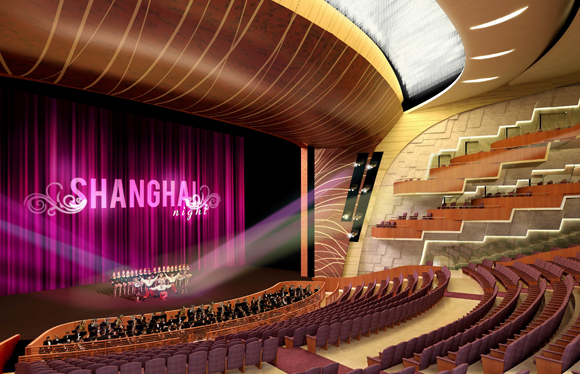
The cocktail party description of what I do as a theatre consultant is “plan and design performing arts theatres and facilities, as well as the technical production systems for them.” There are many elements of service that go into it, but that’s the bullet. The next question is almost always about acoustics, and, well, that’s a complex enough field that it has its own profession, with which we work closely, but we don’t do it in-house. While the architects we work with are at the top of the pyramid, we are specialists who bridge the creative and technical worlds of the performing arts with architecture, engineering, and construction.
Some of our work is with architects who have done theatres before, some not. And, of course, there is a varying degree of opportunity to explore the possibilities in depth. But it’s always a unique experience, because it’s a synthesized building type, mixing all the good stuff of architectural practice: public structures for human interaction and a complicated weaving of art, pragmatics, engineering gymnastics, and capital vs. operating dollar and time budgets, which together make for a construction process that is all but simple.
When we work with architects who have not designed a theatre before, the first thing we need to do is give them a perspective beyond their experience as an audience member on the receiving end of the story being told. We draw on that experience and perhaps help them understand it better, but we need to pull back the curtain and describe what goes into telling that story. I advise an architect doing a theatre for the first time—as I advise the contractors, who are almost always first-timers—attend first to what you know least about.
In designing places for live performance, we have technical requirements to meet, but we must go beyond the pragmatics, because we are responsible not only to accommodate how people see and hear; we need to affect how people feel. We want our audience to be bound in a community and taken in by the story. The more human the place, the closer we can get our audience to be touched by art, and the more the reactive energy of the audience comes back to the performers, fueling them. When this purpose of making a human place is ignored, we are treating our audience with disrespect.
I grew up in the profession in a marvelous time when we were being rescued from post-war, distinctly mathematical solutions to theatre design. In the ‘50s through the ‘70s, as many things were being dissected, theatre planning spent a largely dark era focused on the “perfect” theatre, on the sole need of audiences to see and hear, something that could be solved with simple geometric rules derived in plan and section. Often, these geometries were merely extruded into rooms. But, just as dissection is an inquiry unfortunate for the frog, what we were left with had no soul. If a room has no soul, how can it put the audience in a ready state to absorb and reflect the soul that the performers are pouring out?
While seeing and hearing are fundamental, they are themselves artless. Of course we need to see what’s happening and hear it in the way appropriate for its type, but we need to feel it, as well, and that’s where the architecture needs to rise above the formulae and pull it all together—pull us all together. Yet, we designers need to be humble, in much the same way we would approach designing a gallery. When the lights dim, we want the audience to forget where they are.
We use the term intimacy when we talk about the audience experience and the actor-audience relationship. Intimacy depends on how we position people in relation to each other and to the stage, but also on how we scale the room with architectural moments. We know this, because you can be in an auditorium alone with no performance and feel that it is intimate. So, if the room feels intimate even when you are alone in it, it must be that it comes from the built form and our perception of it—from the subtleties of illumination’s effect and the solemnity of silence. Thus, we can achieve spatial intimacy through the management of scale and warmth, and the sculpting of a place.
In an audience, emotion is a contagion that spreads, so we want to have other audience members, if only subtly, as part of one another’s perspective. This is an outcome of the care we take in the curvature of the rows, the sightline target including not only the stage but also some of the audience, and is one of the results of having side boxes at various levels. Certainly, one of the uses of boxes is to define areas for VIP (elevated revenue) seating, but there is more to it. They serve to “people the walls”; they provide the acoustic benefit of introducing surfaces for sound to cue-ball back to the audience sooner than from the side walls; and they scale down what would otherwise be a tall, distant, uninterrupted side wall, providing a surface with their front rail as a necklace and connecting the balcony to the proscenium. The box and balcony fronts form a pair of outstretched arms, starting preferably at the stage, extending on both sides, and giving the audience a big hug. Shape them, detail them, and illuminate them, and they are significant players in sculpting the dominant volume.
We desperately need to make the room feel smaller than it is, whether that is small or large. If it feels smaller, we feel bigger, and vice versa. If we feel small in a giant room, how can we have an impact, or how can a group remain energetic? And if we don’t have an impact, the place is dead. We have other architectural tools in our quiver, like intermediate pony walls among the audience; and we can push proscenium-like forms into the audience to draw you in close. Most importantly, we again illuminate these form-givers so they read more prominently than the outermost walls that ultimately contain the space.
As I mentioned, we have the fortune to work with related professionals who consult in acoustics. The ones we enjoy most are those who sit at the table and assert that, although in schematic design they will provide some geometric acoustic criteria diagrams, for heavens sake, don’t build them! Again, theatres don’t come to life if they are two-dimensional diagrams of reflective surfaces that become the too-literal basis for a room. This living room should change as you move about it.
Lastly, I need to warn you that we are in need of what can be a substantial piece of the budget to provide the engineering infrastructure and systems that are largely backstage, in order to make the theatre magic go. It’s the table in the operating room: without it, we can’t do what we set out to. All live performance theatres are places where people make things so that a story can be told. To mount a production is a highly collaborative and accelerated planning-conceiving-design-construction-opening effort, on top of the director’s and performers’ interpretation of the script or score. Theatres need the tools to efficiently support the art and to have the most creative flexibility possible. They cannot be hampered by obstacles that cause the expense of unnecessary time—because, in theatre, time is money, and also time is time: if operations can happen faster, we can do more and better theatre.

Author Adam Shalleck, AIA, founded The Shalleck Collaborative in San Francisco in 2003, after fifteen years with other leading theatre consultants.
Originally published 4th quarter 2008, in arcCA 08.4, “Interiors + Architecture.”





